Nanotubes Formation in P. aeruginosa
Abstract
1. Introduction
2. Material and Methods
2.1. Bacterial Strains, Identification and Growth
2.2. Formation of Biofilm
2.3. Cell Segregation
2.4. Cell Surface Hydrophobicity Assay
2.5. RNA Extraction and RT-PCR
- mreB_F 5′-GGCTCGATGGTCGTAGACA-3′
- mreB_R 5′-ACGTAGGTGACGATGGCTTC-3′.
- oprI_F 5′-AGCAGCCACTCCAAAGAAAC-3′
- oprI_R 5′-CAGAGCTTCGTCAGCCTTG-3′.
2.6. Effect of Triton X100 on biofilms
2.7. Electron Microscopy
2.8. Image Processing
2.9. Statistical Analysis
3. Results
3.1. The mreB and oprF Gene Expression in P. aeruginosa
3.2. Cell Segregation
3.3. Effect of Triton X100 on Biofilms
3.4. Optical Density
3.5. Nanotube in Mix Culture of P. aeruginosa, E. coli and S. aureus
3.6. Effect of Temperature Change on Nanotube Formation
3.7. Cell Surface Hydrophobicity before and after Nanotube Development
4. Discussion
Author Contributions
Funding
Institutional Review Board Statement
Informed Consent Statement
Data Availability Statement
Acknowledgments
Conflicts of Interest
References
- Lyczak, J.B.; Cannon, C.L.; Pier, G.B. Establishment of Pseudomonas aeruginosa infection: Lessons from a versatile opportunist. Microbes. Infect. 2000, 2, 1051–1060. [Google Scholar] [CrossRef]
- Zarei, O.; Shokoohizadeh, L.; Hossainpour, H.; Alikhani, M.Y. Molecular analysis of Pseudomonas aeruginosa isolated from clinical, environmental and cockroach sources by ERIC-PCR. BMC Res. Notes 2018, 11, 668. [Google Scholar] [CrossRef] [PubMed]
- Ciofu, O.; Tolker-Nielsen, T. Tolerance and resistance of Pseudomonas aeruginosa biofilms to antimicrobial agents-how P. aeruginosa can escape antibiotics. Front. Microbiol. 2019, 10, 913. [Google Scholar] [CrossRef] [PubMed]
- Tamma, P.D.; Aitken, S.L.; Bonomo, R.A.; Mathers, A.J.; Van Duin, D.; Clancy, C.J. Infectious Diseases Society of America guidance on the treatment of extended-spectrum β-lactamase producing Enterobacterales (ESBL-E), carbapenem-resistant Enterobacterales (CRE), and Pseudomonas aeruginosa with difficult-to-treat resistance (DTR-P. aeruginosa). Clin. Infect. Dis. 2021, 72, 169–183. [Google Scholar]
- Yin, W.; Wang, Y.; Liu, L.; He, J. Biofilms: The microbial “protective clothing” in extreme environments. Int. J. Mol. Sci. 2019, 20, 3423. [Google Scholar] [CrossRef] [PubMed]
- Saxena, P.; Joshi, Y.; Rawat, K.; Bisht, R. Biofilms: Architecture, resistance, quorum sensing and control mechanisms. Indian J. Micro. 2019, 59, 3–12. [Google Scholar] [CrossRef] [PubMed]
- Mirani, Z.A.; Urooj, S.; Ullah, A.; Khan, M.N.; Rauf, N.; Mehmood, A.; Fenghuan, W.; Shaikh, I.A.; Khan, A.B. Phenotypic Heterogeneity in Biofilm Consortia of E. coli. Microbiology 2021, 90, 237–246. [Google Scholar] [CrossRef]
- Das, T.; Manoharan, A.; Whiteley, G.; Glasbey, T.; Manos, J. Pseudomonas aeruginosa biofilms and infections: Roles of extracellular molecules. In New and Future Developments in Microbial Biotechnology and Bioengineering: Microbial Biofilms; Elsevier: Amsterdam, The Netherlands, 2020; pp. 29–46. [Google Scholar]
- Castellano, P.; Pérez-Ibarreche, M.; Blanco-Massani, M.; Fontana, C.; Vignolo, G.M. Strategies for pathogen biocontrol using lactic acid bacteria and their metabolites: A focus on meat ecosystems and industrial environments. Microorganisms 2017, 5, 38. [Google Scholar] [CrossRef] [PubMed]
- Xu, A.; Zhang, X.; Wang, T.; Xin, F.; Ma, L.Z.; Zhou, J.; Dong, W.; Jiang, M. Rugose small colony variant and its hyper-biofilm in Pseudomonas aeruginosa: Adaption, evolution, and biotechnological potential. Biotechnol. Adv. 2021, 53, 107862. [Google Scholar] [CrossRef]
- Gloag, E.S.; German, G.K.; Stoodley, P.; Wozniak, D.J. Viscoelastic properties of Pseudomonas aeruginosa variant biofilms. Sci. Rep. 2018, 8, 9691. [Google Scholar] [CrossRef] [PubMed]
- Chang, C.Y. Surface sensing for biofilm formation in Pseudomonas aeruginosa. Front. Microbiol. 2018, 8, 2671. [Google Scholar] [CrossRef] [PubMed]
- Barken, K.B.; Pamp, S.J.; Yang, L.; Gjermansen, M.; Bertrand, J.J.; Klausen, M.; Givskov, M.; Whitchurch, C.B.; Engel, J.N.; Tolker-Nielsen, T. Roles of type IV pili, flagellum-mediated motility and extracellular DNA in the formation of mature multicellular structures in Pseudomonas aeruginosa biofilms. Environ. Microbiol. 2008, 10, 2331–2343. [Google Scholar] [CrossRef] [PubMed]
- Oldewurtel, E.R.; Kouzel, N.; Dewenter, L.; Henseler, K.; Maier, B. Differential interaction forces govern bacterial sorting in early biofilms. Elife 2015, 4, e10811. [Google Scholar] [CrossRef]
- Zurzolo, C. Tunneling nanotubes: Reshaping connectivity. Curr. Opin. Cell Biol. 2021, 71, 139–147. [Google Scholar] [CrossRef] [PubMed]
- Matkó, J.; Tóth, E.A. Membrane nanotubes are ancient machinery for cell-to-cell communication and transport. Their interference with the immune system. Biol. Futura. 2021, 72, 25–36. [Google Scholar] [CrossRef] [PubMed]
- Stempler, O.; Baidya, A.K.; Bhattacharya, S.; Malli Mohan, G.B.; Tzipilevich, E.; Sinai, L.; Mamou, G.; Ben-Yehuda, S. Interspecies nutrient extraction and toxin delivery between bacteria. Nat. Commun. 2017, 8, 315. [Google Scholar] [CrossRef]
- Cao, Y.; Jana, S.; Bowen, L.; Liu, H.; Jakubovics, N.S.; Chen, J. Bacterial nanotubes mediate bacterial growth on periodic nano-pillars. Soft Matter. 2020, 16, 7613–7623. [Google Scholar] [CrossRef]
- Dubey, G.P.; Ben-Yehuda, S. Intercellular nanotubes mediate bacterial communication. Cell 2011, 144, 590–600. [Google Scholar] [CrossRef]
- Pospíšil, J.; Vítovská, D.; Kofroňová, O.; Muchová, K.; Šanderová, H.; Hubálek, M.; Šiková, M.; Modrák, M.; Benada, O.; Barák, I.; et al. Bacterial nanotubes as a manifestation of cell death. Nat. Commun. 2020, 11, 4963. [Google Scholar] [CrossRef]
- De Vos, D.; Lim, A., Jr.; Pirnay, J.P.; Duinslaeger, L.; Revets, H.; Vanderkelen, A.; Hamers, R.; Cornelis, P. Analysis of epidemic Pseudomonas aeruginosa isolated by isoelectric focusing of pyoverdine and RAPD-PCR: Modern tools for an integrated anti-nosocomial infection strategy in burn wound centres. Burns 1997, 23, 379–386. [Google Scholar] [CrossRef]
- Mirani, Z.A.; Urooj, S.; Zeesahn, F.; Khan, M.N.; Mubashir, A.Z.İ.Z.; Shaikh, I.A.; Khan, A.B. Role of phenotypic switching in stability and persistence of Pseudomonas aeruginosa biofilms. Clin. Microbiol. Infect. 2020, 10, 10–17. [Google Scholar] [CrossRef][Green Version]
- Kranjec, C.; Ovchinnikov, K.V.; Grønseth, T.; Ebineshan, K.; Srikantam, A.; Diep, D.B. A bacteriocin-based antimicrobial formulation to effectively disrupt the cell viability of methicillin-resistant Staphylococcus aureus (MRSA) biofilms. NPJ Biofilms Microbiomes 2020, 6, 58. [Google Scholar] [CrossRef] [PubMed]
- Monsen, T.; Lövgren, E.; Widerström, M.; Wallinder, L. In vitro effect of ultrasound on bacteria and suggested protocol for sonication and diagnosis of prosthetic infections. J. Clin. Microbiol. 2009, 47, 2496–2501. [Google Scholar] [CrossRef] [PubMed]
- Kouidhi, B.; Zmantar, T.; Hentati, H.; Bakhrouf, A. Cell surface hydrophobicity, biofilm formation, adhesives properties and molecular detection of adhesins genes in Staphylococcus aureus associated to dental caries. Microb. Pathog. 2010, 49, 14–22. [Google Scholar] [CrossRef]
- Tortuel, D.; Tahrioui, A.; Rodrigues, S.; Cambronel, M.; Boukerb, A.M.; Maillot, O.; Verdon, J.; Bere, E.; Nusser, M.; Brenner-Weiss, G.; et al. Activation of the cell wall stress response in Pseudomonas aeruginosa infected by a Pf4 phage variant. Microorganisms 2020, 8, 1700. [Google Scholar] [CrossRef] [PubMed]
- Mirani, Z.A.; Fatima, A.; Urooj, S.; Aziz, M.; Khan, M.N.; Abbas, T. Relationship of cell surface hydrophobicity with biofilm formation and growth rate: A study on Pseudomonas aeruginosa, Staphylococcus aureus, and Escherichia coli. Iran. J. Basic Med. Sci. 2018, 21, 760. [Google Scholar]
- Dufrene, Y.F.; Persat, A. Mechanomicrobiology: How bacteria sense and respond to forces. Nat. Rev. Microbiol. 2020, 18, 227–240. [Google Scholar] [CrossRef]
- McDougald, D.; Rice, S.A.; Barraud, N.; Steinberg, P.D.; Kjelleberg, S. Should we stay or should we go: Mechanisms and ecological consequences for biofilm dispersal. Nat. Rev. Microbiol. 2012, 10, 39–50. [Google Scholar] [CrossRef]
- Molin, S.; Tolker-Nielsen, T.; Hansen, S.K. Microbial Interactions in Mixed-Species Biofilms; Wiley: Hoboken, NJ, USA, 2004; pp. 206–222. [Google Scholar]
- Moormeier, D.E.; Bayles, K.W. Staphylococcu saureus biofilm: A complex developmental organism. Mol. Microbiol. 2017, 104, 365–376. [Google Scholar] [CrossRef]
- Thompson, K.M.; Jefferson, K.K. Adaptation to stress: Biofilms and small colony variants. In Staphylococci in Human Disease; Crossley, K.B., Jefferson, K.K., Archer, G.L., Fowler, V.G., Eds.; Blackwell: Oxford, UK, 2009; pp. 109–124. [Google Scholar]
- Pande, S.; Shitut , S.; Freund, L.; Westermann, M.; Bertels, F.; Colesie, C.; Bischofs, I.B.; Kost, C. Metabolic cross-feeding via intercellular nanotubes among bacteria. Nat. Commun. 2015, 6, 6238. [Google Scholar] [CrossRef]
- Dubey, G.P.; Mohan, G.B.M.; Dubrovsky, A.; Amen, T.; Tsipshtein, S.; Rouvinski, A.; Rosenberg, A.; Kaganovich, D.; Sherman, E.; Medalia, O.; et al. Architecture and characteristics of bacterial nanotubes. Dev. Cell 2016, 36, 453–461. [Google Scholar] [CrossRef] [PubMed]
- Baidya, A.K.; Rosenshine, I.; Ben-Yehuda, S. Donor-delivered cell wall hydrolases facilitate nanotube penetration into recipient bacteria. Nat. Commun. 2020, 11, 1938. [Google Scholar] [CrossRef] [PubMed]
- Kovach, K.; Davis-Fields, M.; Irie, Y.; Jain, K.; Doorwar, S.; Vuong, K.; Dhamani, N.; Mohanty, K.; Touhami, A.; Gordon, V.D. Evolutionary adaptations of biofilms infecting cystic fibrosis lungs promote mechanical toughness by adjusting polysaccharide production. NPJ Biofilms Microbiomes 2017, 3, 1. [Google Scholar] [CrossRef] [PubMed]
- Galy, O.; Latour-Lambert, P.; Zrelli, K.; Ghigo, J.M.; Beloin, C.; Henry, N. Mapping of bacterial biofilm local mechanics by magnetic microparticle actuation. Biophys. J. 2012, 103, 1400–1408. [Google Scholar] [CrossRef]
- Baidya, A.K.; Bhattacharya, S.; Dubey, G.P.; Mamou, G.; Ben-Yehuda, S. Bacterial nanotubes: A conduit for intercellular molecular trade. Curr. Opin. Microbiol. 2018, 42, 1–6. [Google Scholar] [CrossRef]
- Toro, E.; Shapiro, L. Bacterial chromosome organization and segregation. Cold Spring Harb. Perspect. Biol. 2010, 2, 000349. [Google Scholar] [CrossRef]
- Benomar, S.; Ranava, D.; Cárdenas, M.L.; Trably, E.; Rafrafi, Y.; Ducret, A.; Hamelin, J.; Lojou, E.; Steyer, J.P.; Giudici-Orticoni, M.T. Nutritional stress induces exchange of cell material and energetic coupling between bacterial species. Nat. Commun. 2015, 6, 6283. [Google Scholar] [CrossRef]
- Patel, N.; Yamada, Y.; Azam, F. Bacterial Nanotubes as Intercellular Linkages in Marine Assemblages. Front. Mar. Sci. 2021, 9. [Google Scholar] [CrossRef]
- Barton, B.; Grinnell, A.; Morgenstein, R.M. Disruption of the MreB Elongasome Is Overcome by Mutations in the Tricarboxylic Acid Cycle. Front. Microbiol. 2021, 12. [Google Scholar] [CrossRef]
- Bouffartigues, E.; Gicquel, G.; Bazire, A.; Bains, M.; Maillot, O.; Vieillard, J.; Feuilloley, M.G.; Orange, N.; Hancock, R.E.W.; Dufour, A.; et al. Transcription of the oprF gene of Pseudomonas aeruginosa is dependent mainly on the SigX sigma factor and is sucrose induced. J. Bacteriol. 2012, 194, 4301–4311. [Google Scholar] [CrossRef]
- Bouffartigues, E.; Moscoso, J.A.; Duchesne, R.; Rosay, T.; Fito-Boncompte, L.; Gicquel, G.; Maillot, O.; Bénard, M.; Bazire, A.; Brenner-Weiss, G.; et al. The absence of the Pseudomonas aeruginosa OprF protein leads to increased biofilm formation through variation in c-di-GMP level. Front. Microbiol. 2015, 6, 630. [Google Scholar] [CrossRef] [PubMed]
- Kotzialampou, A.; Protonotariou, E.; Skoura, L.; Sivropoulou, A. Synergistic Antibacterial and Antibiofilm Activity of the MreB Inhibitor A22 Hydrochloride in Combination with Conventional Antibiotics against Pseudomonas aeruginosa and Escherichia coli Clinical Isolates. Int. J. Microbiol. 2021, 25, 3057754. [Google Scholar] [CrossRef] [PubMed]
- Schnaitman, C.A. Effect of ethylenediaminetetraacetic acid, Triton X-100, and lysozyme on the morphology and chemical composition of isolated cell walls of Escherichia coli. J. Bacteriol. 1971, 108, 553–563. [Google Scholar] [CrossRef] [PubMed]
- Meysman, F.J.; Cornelissen, R.; Trashin, S.; Bonné, R.; Martinez, S.H.; van der Veen, J.; Blom, C.J.; Karman, C.; Hou, J.L.; Eachambadi, R.T.; et al. A highly conductive fibre network enables centimetre-scale electron transport in multicellular cable bacteria. Nat. Commun. 2019, 10, 4120. [Google Scholar] [CrossRef]

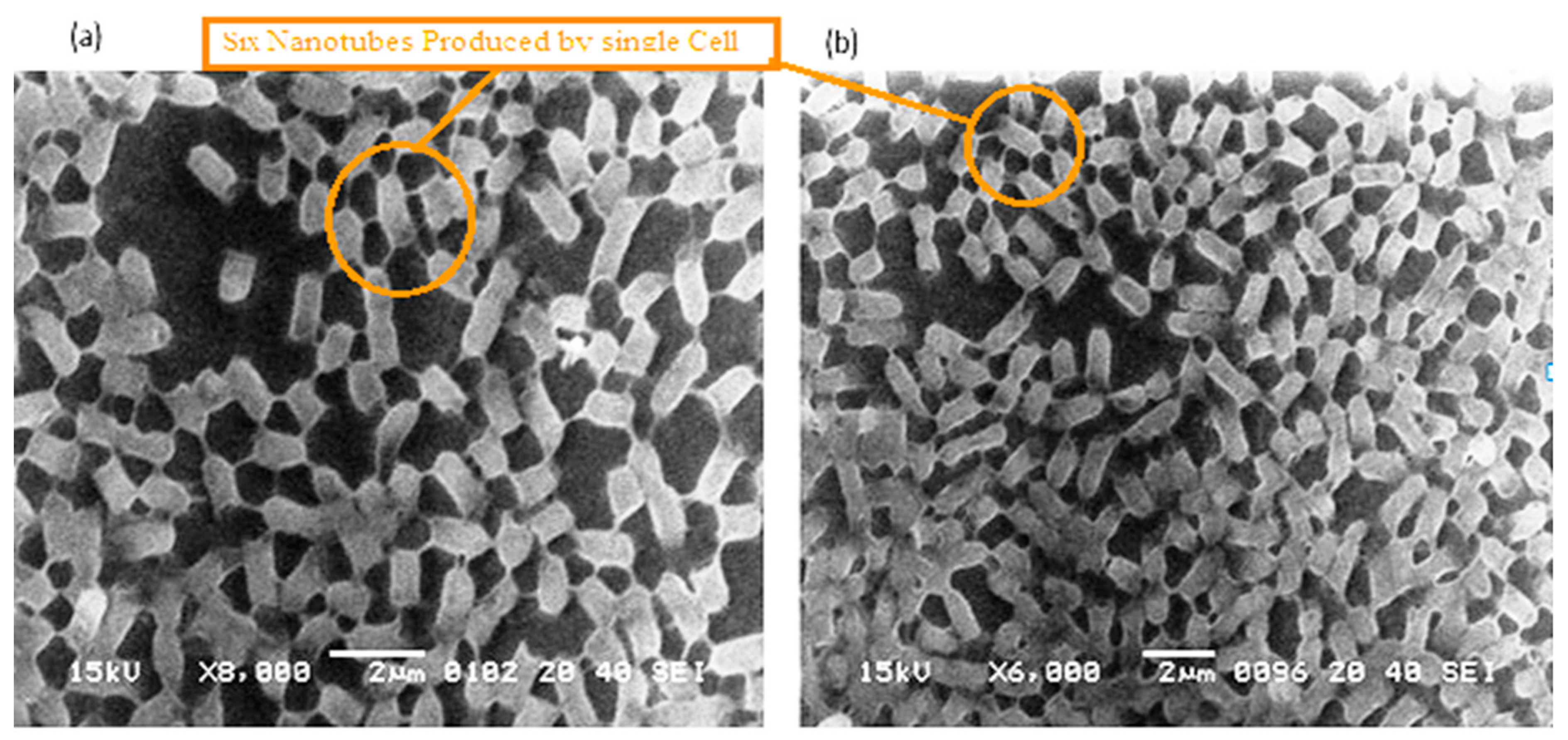
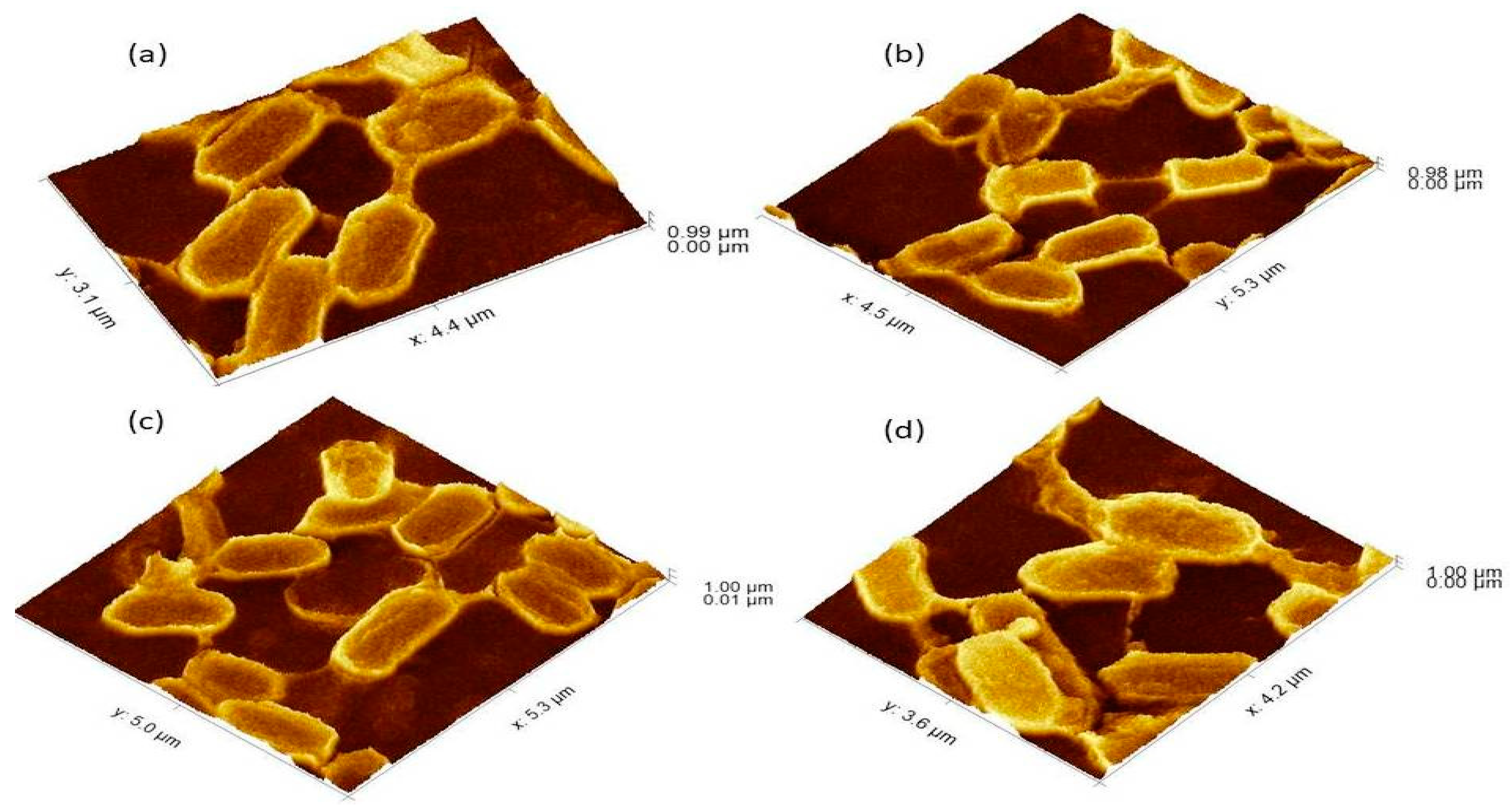
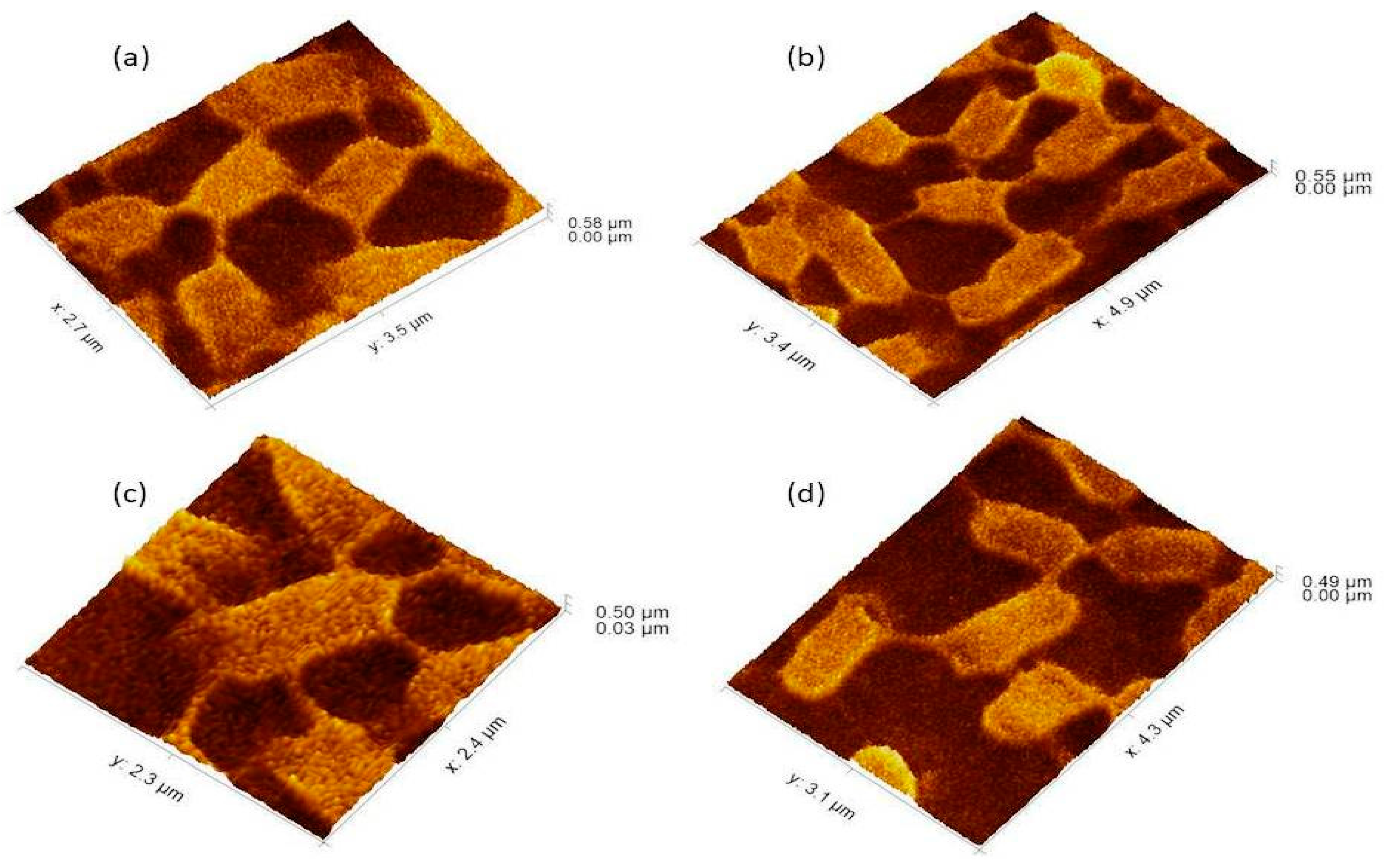
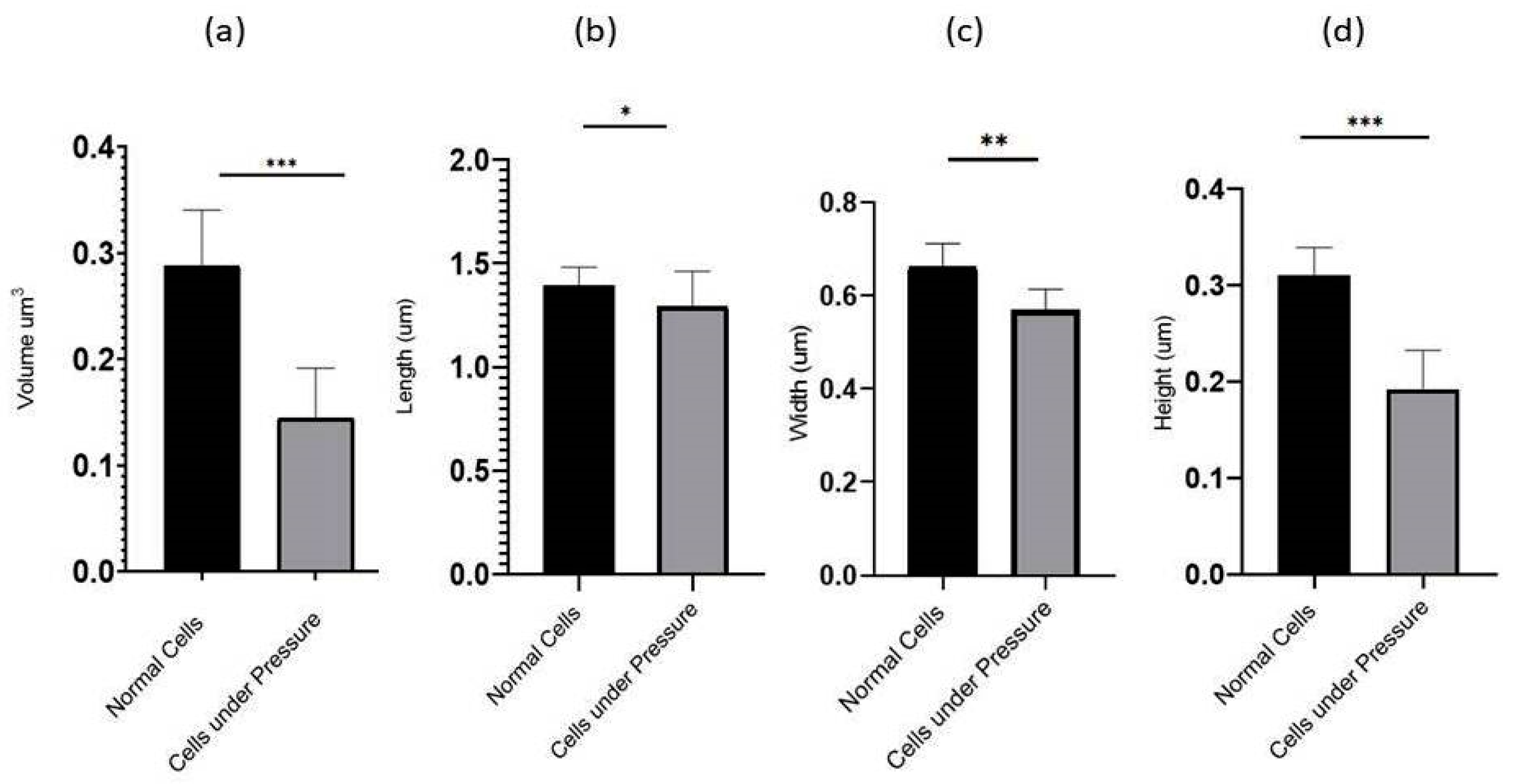
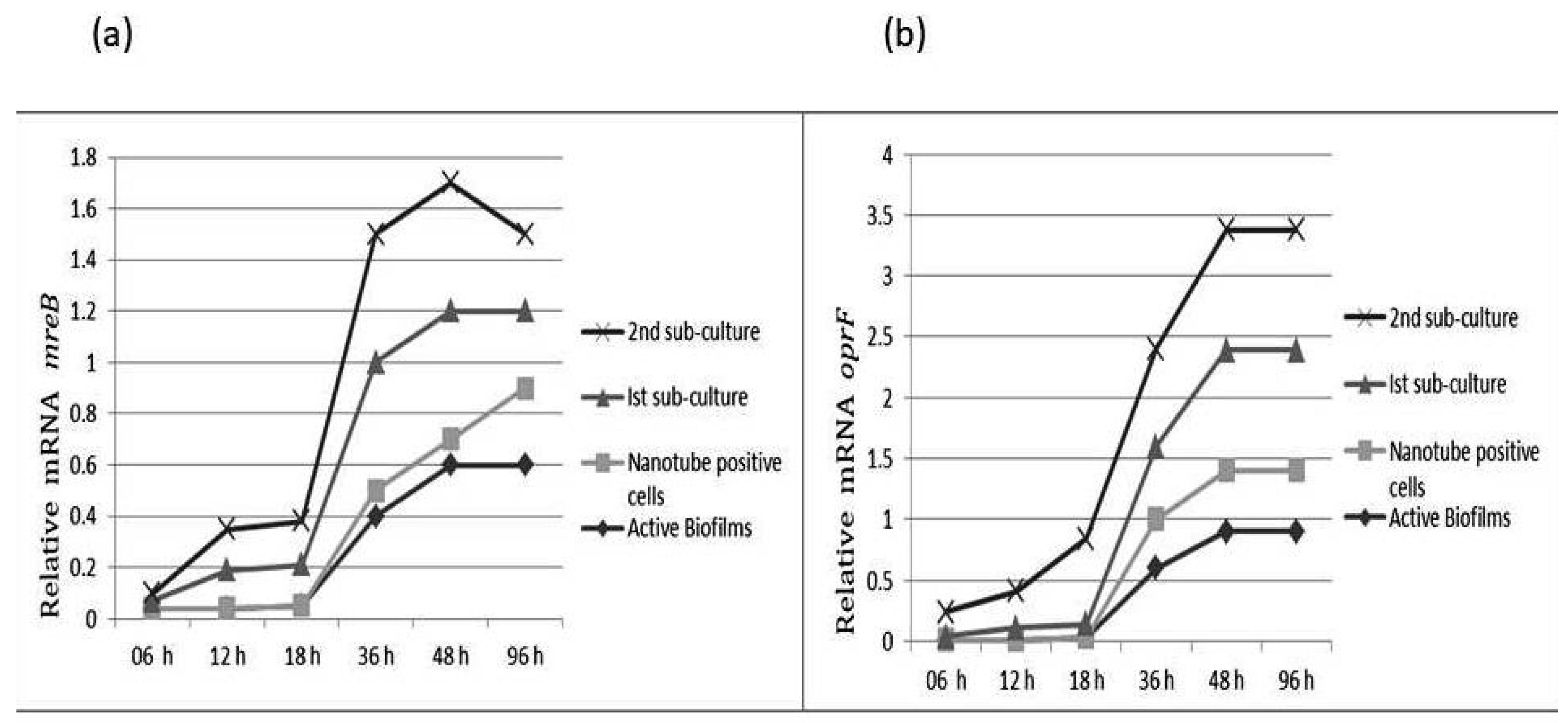
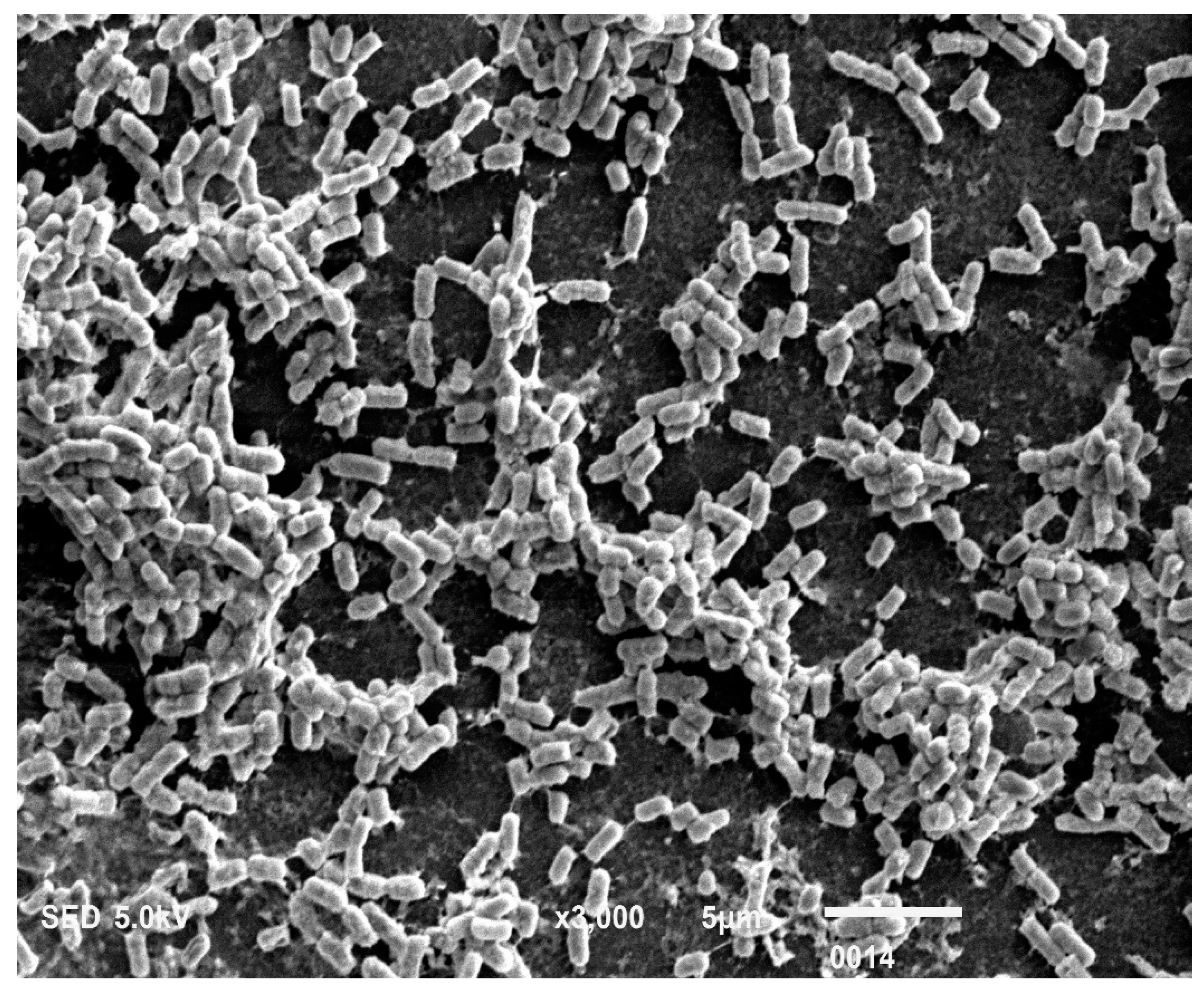
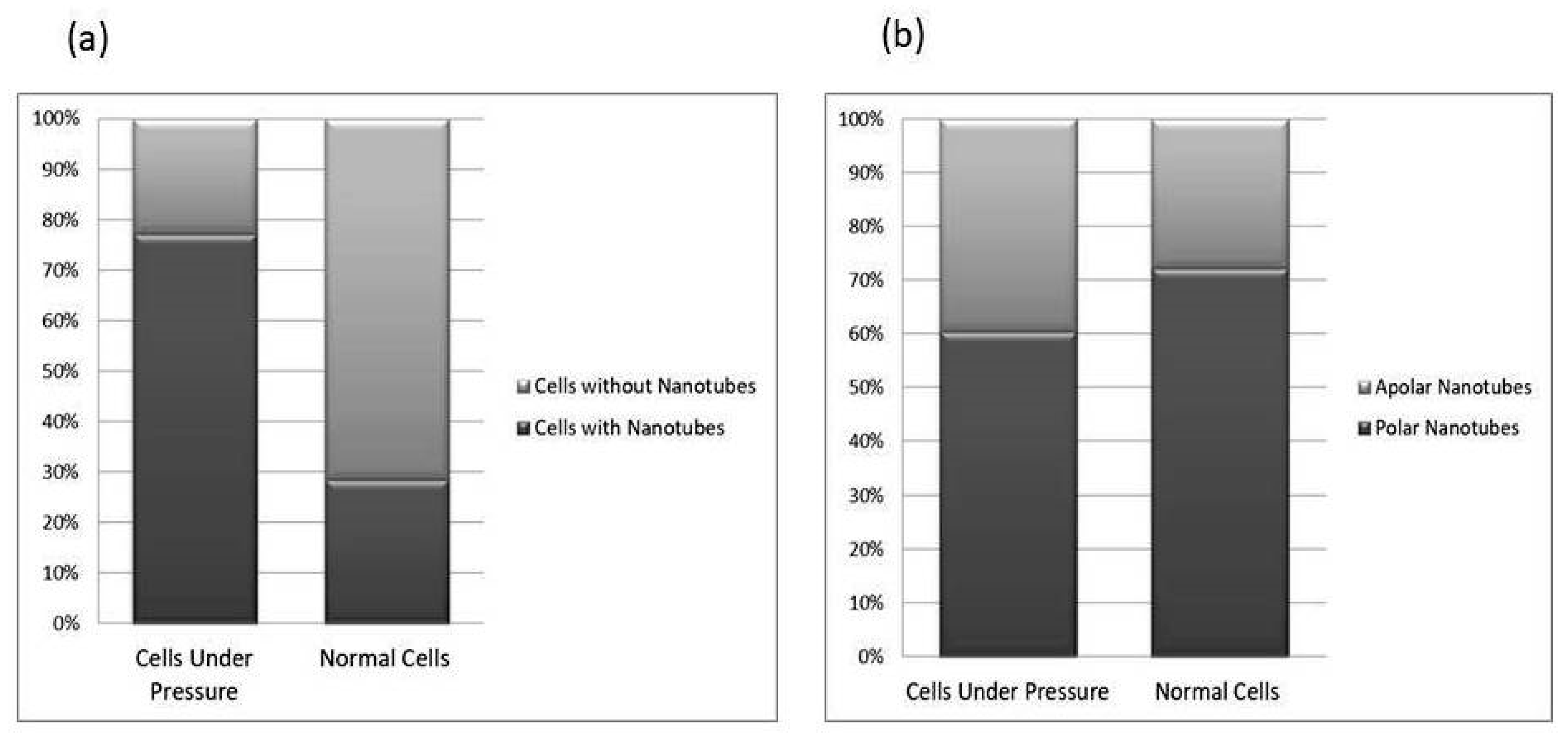
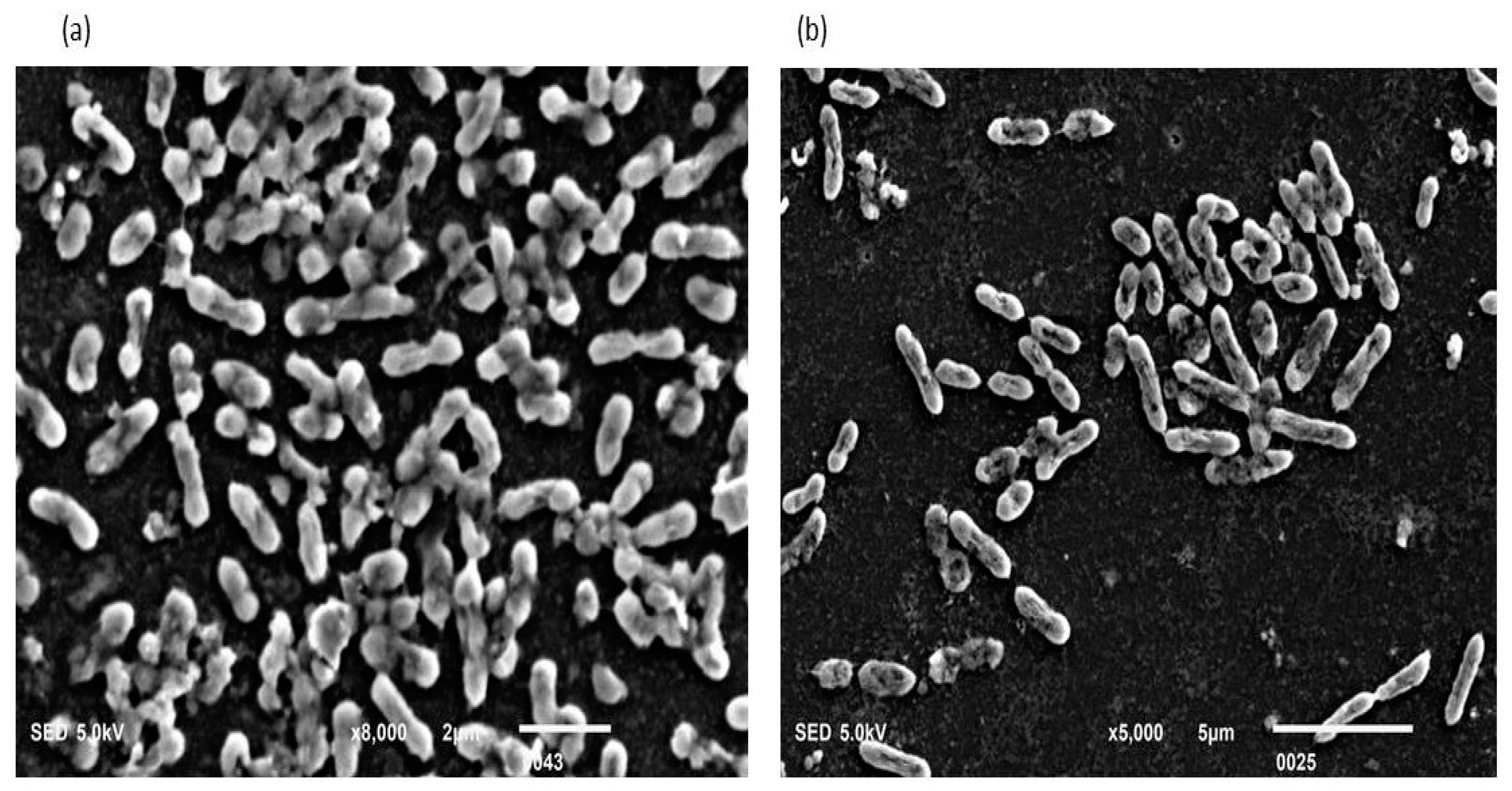
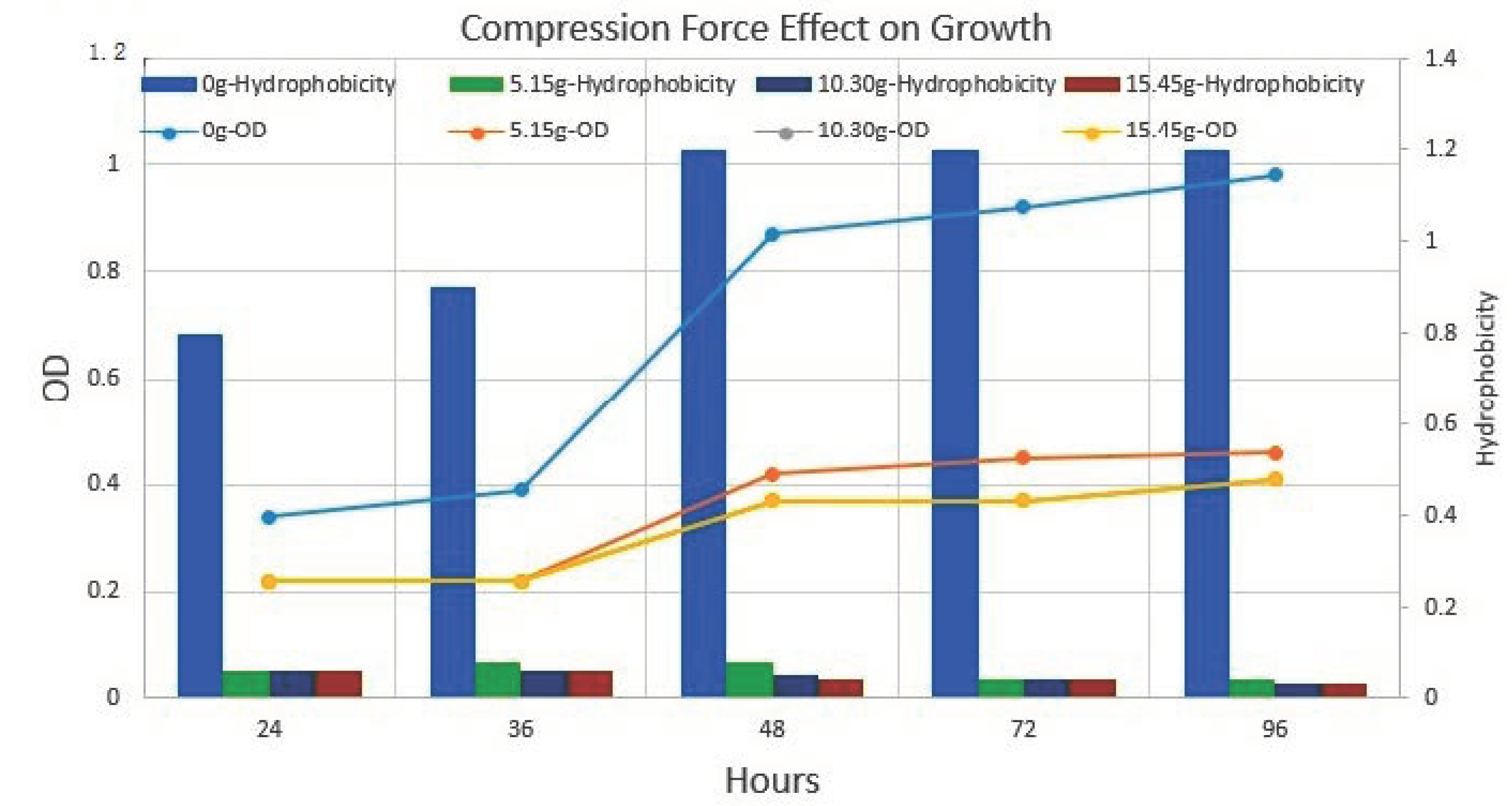
| Normal Cells and Nanotube Measurements | ||||||||||
|---|---|---|---|---|---|---|---|---|---|---|
| Normal Cells Measurements | Nanotubes Measurements | |||||||||
| Length (um) | Width (um) | Height (um) | Volume (um3) | Nanotubes | Polar | A-Polar | Length (nm) | Width (nm) | Height (nm) | Volume (um3) |
| 1.53 | 0.66 | 0.32 | 0.323 | 1 | 1 | 0 | 545 | 163 | 162 | 0.0143 |
| 1.41 | 0.68 | 0.29 | 0.278 | 0 | 0 | 0 | ||||
| 1.37 | 0.71 | 0.33 | 0.320 | 2 | 1 | 1 | * 704 | *143 | * 118 | 0.0118 |
| 1.41 | 0.64 | 0.29 | 0.261 | 0 | 0 | 0 | ||||
| 1.47 | 0.61 | 0.31 | 0.277 | 0 | 0 | 0 | ||||
| 1.44 | 0.59 | 0.28 | 0.237 | 2 | 1 | 1 | * 714 | * 117 | * 169 | 0.0141 |
| 1.58 | 0.71 | 0.34 | 0.381 | 0 | 0 | 0 | ||||
| 1.49 | 0.59 | 0.30 | 0.263 | 0 | 0 | 0 | ||||
| 1.47 | 0.58 | 0.31 | 0.264 | 0 | 0 | 0 | ||||
| 1.37 | 0.72 | 0.35 | 0.345 | 0 | 0 | 0 | ||||
| 1.36 | 0.64 | 0.34 | 0.295 | 0 | 0 | 0 | ||||
| 1.33 | 0.67 | 0.32 | 0.285 | 0 | 0 | 0 | ||||
| 1.57 | 0.74 | 0.38 | 0.441 | 4 | 3 | 1 | * 946 | * 155 | * 206 | 0.0302 |
| 1.58 | 0.62 | 0.33 | 0.323 | 0 | 0 | 0 | ||||
| 1.34 | 0.72 | 0.31 | 0.299 | 0 | 0 | 0 | ||||
| 1.30 | 0.71 | 0.33 | 0.304 | 1 | 1 | 0 | 442 | 98 | 222 | 0.0096 |
| 1.34 | 0.67 | 0.29 | 0.260 | 0 | 0 | 0 | ||||
| 1.36 | 0.69 | 0.29 | 0.272 | 1 | 1 | 0 | 336 | 231 | 276 | 0.0214 |
| 1.33 | 0.67 | 0.25 | 0.222 | 0 | 0 | 0 | ||||
| 1.26 | 0.64 | 0.27 | 0.217 | 0 | 0 | 0 | ||||
| 1.35 | 0.64 | 0.29 | 0.250 | 0 | 0 | 0 | ||||
| 1.33 | 0.68 | 0.31 | 0.280 | 3 | 2 | 1 | * 454 | * 94 | * 168 | 0.0071 |
| 1.25 | 0.66 | 0.29 | 0.239 | 0 | 0 | 0 | ||||
| 1.42 | 0.76 | 0.34 | 0.366 | 0 | 0 | 0 | ||||
| 1.22 | 0.61 | 0.28 | 0.208 | 0 | 0 | 0 | ||||
| 1.37 | 0.72 | 0.33 | 0.325 | 0 | 0 | 0 | ||||
| 1.35 | 0.74 | 0.33 | 0.329 | 0 | 0 | 0 | ||||
| 1.37 | 0.62 | 0.26 | 0.220 | 0 | 0 | 0 | ||||
| 1.39 | 0.64 | 0.32 | 0.284 | 2 | 1 | 1 | * 592 | * 121 | * 314 | 0.0224 |
| 1.33 | 0.61 | 0.31 | 0.251 | 1 | 1 | 0 | 756 | 183 | 258 | 0.0356 |
| 1.39 | 0.66 | 0.28 | 0.256 | 0 | 0 | 0 | ||||
| 1.41 | 0.73 | 0.37 | 0.380 | 0 | 0 | 0 | ||||
| 1.36 | 0.61 | 0.31 | 0.257 | 0 | 0 | 0 | ||||
| 1.38 | 0.61 | 0.29 | 0.244 | 0 | 0 | 0 | ||||
| 1.52 | 0.63 | 0.32 | 0.306 | 1 | 1 | 0 | 488 | 147 | 128 | 0.0091 |
| * 1.392 | * 0.662 | * 0.310 | * 0.288 | ** 18 | 72.2% | 27.8% | * 597.7 | * 145.2 | * 202.1 | * 0.005 |
| Cells under Pressure and Nanotube Measurements | ||||||||||
|---|---|---|---|---|---|---|---|---|---|---|
| Cells under Pressure Measurements | Nanotubes Measurements | |||||||||
| Length (um) | Width (um) | Height (um) | Volume (um3) | Nanotube/s | Polar | A-Polar | Length (nm) | Width (nm) | Height (nm) | Volume (um3) |
| 1.16 | 0.54 | 0.14 | 0.087 | 4 | 3 | 1 | * 458 | * 144 | * 106 | 0.006 |
| 1.35 | 0.52 | 0.19 | 0.133 | 0 | 0 | 0 | ||||
| 1.12 | 0.52 | 0.13 | 0.075 | 2 | 1 | 1 | * 488 | * 152 | * 60 | 0.004 |
| 1.54 | 0.63 | 0.21 | 0.203 | 1 | 1 | 0 | 431 | 198 | 85 | 0.007 |
| 1.61 | 0.63 | 0.19 | 0.192 | 4 | 2 | 2 | * 411 | * 144 | * 116 | 0.006 |
| 1.17 | 0.62 | 0.19 | 0.137 | 1 | 1 | 0 | 254 | 162 | 97 | 0.003 |
| 1.51 | 0.61 | 0.22 | 0.202 | 4 | 3 | 1 | * 429 | * 187 | * 86 | 0.006 |
| 1.24 | 0.59 | 0.19 | 0.139 | 4 | 1 | 3 | * 376 | * 106 | * 100 | 0.003 |
| 1.33 | 0.61 | 0.17 | 0.137 | 4 | 3 | 1 | * 433 | * 147 | * 60 | 0.003 |
| 1.17 | 0.53 | 0.16 | 0.099 | 0 | 0 | 0 | ||||
| 1.26 | 0.59 | 0.15 | 0.111 | 4 | 2 | 2 | * 185 | * 147 | * 128 | 0.003 |
| 1.24 | 0.61 | 0.19 | 0.143 | 3 | 1 | 2 | * 588 | * 142 | * 98 | 0.008 |
| 1.36 | 0.62 | 0.17 | 0.143 | 1 | 0 | 1 | 765 | 164 | 136 | 0.017 |
| 1.14 | 0.61 | 0.17 | 0.118 | 0 | 0 | 0 | ||||
| 1.01 | 0.61 | 0.16 | 0.098 | 2 | 1 | 1 | * 478 | * 147 | * 94 | 0.006 |
| 1.17 | 0.53 | 0.12 | 0.074 | 4 | 2 | 2 | * 473 | * 114 | * 82 | 0.004 |
| 1.23 | 0.63 | 0.24 | 0.185 | 4 | 2 | 2 | * 485 | * 123 | * 64 | 0.003 |
| 1.18 | 0.57 | 0.19 | 0.127 | 3 | 1 | 2 | * 491 | * 133 | * 88 | 0.005 |
| 1.32 | 0.55 | 0.18 | 0.130 | 1 | 1 | 0 | 522 | 139 | 74 | 0.005 |
| 1.42 | 0.55 | 0.17 | 0.132 | 1 | 1 | 0 | 261 | 145 | 107 | 0.004 |
| 1.45 | 0.57 | 0.22 | 0.181 | 0 | 0 | 0 | ||||
| 1.56 | 0.63 | 0.27 | 0.265 | 4 | 2 | 2 | * 421 | * 122 | * 94 | 0.004 |
| 1.15 | 0.51 | 0.14 | 0.082 | 0 | 0 | 0 | ||||
| 0.97 | 0.54 | 0.22 | 0.115 | 1 | 1 | 0 | 379 | 119 | 102 | 0.004 |
| 1.37 | 0.61 | 0.25 | 0.208 | 4 | 3 | 1 | * 428 | * 115 | * 93 | 0.004 |
| 1.34 | 0.57 | 0.19 | 0.145 | 1 | 1 | 0 | 234 | 126 | 114 | 0.003 |
| 1.05 | 0.51 | 0.25 | 0.133 | 3 | 3 | 0 | * 451 | * 132 | * 79 | 0.004 |
| 1.54 | 0.55 | 0.26 | 0.220 | 0 | 0 | 0 | ||||
| 1.36 | 0.55 | 0.26 | 0.194 | 0 | 0 | 0 | ||||
| 1.41 | 0.62 | 0.25 | 0.218 | 2 | 1 | 1 | * 383 | * 104 | * 84 | 0.003 |
| 1.04 | 0.54 | 0.15 | 0.084 | 4 | 2 | 2 | * 394 | * 127 | * 99 | 0.004 |
| 1.33 | 0.5 | 0.17 | 0.113 | 3 | 2 | 1 | * 526 | * 128 | * 81 | 0.005 |
| 1.18 | 0.58 | 0.17 | 0.116 | 3 | 2 | 1 | * 417 | * 135 | * 96 | 0.005 |
| 1.36 | 0.51 | 0.22 | 0.152 | 0 | 0 | 0 | ||||
| 1.58 | 0.51 | 0.18 | 0.145 | 4 | 3 | 1 | * 438 | * 128 | * 116 | 0.006 |
| * 1.292 | * 0.570 | * 0.192 | * 0.144 | ** 76 | 60.52% | 39.4% | * 429.5 | * 138.1 | * 94.03 | * 0.004 |
Publisher’s Note: MDPI stays neutral with regard to jurisdictional claims in published maps and institutional affiliations. |
© 2022 by the authors. Licensee MDPI, Basel, Switzerland. This article is an open access article distributed under the terms and conditions of the Creative Commons Attribution (CC BY) license (https://creativecommons.org/licenses/by/4.0/).
Share and Cite
Ahmed, F.; Mirani, Z.A.; Ahmed, A.; Urooj, S.; Khan, F.Z.; Siddiqi, A.; Khan, M.N.; Imdad, M.J.; Ullah, A.; Khan, A.B.; et al. Nanotubes Formation in P. aeruginosa. Cells 2022, 11, 3374. https://doi.org/10.3390/cells11213374
Ahmed F, Mirani ZA, Ahmed A, Urooj S, Khan FZ, Siddiqi A, Khan MN, Imdad MJ, Ullah A, Khan AB, et al. Nanotubes Formation in P. aeruginosa. Cells. 2022; 11(21):3374. https://doi.org/10.3390/cells11213374
Chicago/Turabian StyleAhmed, Faraz, Zulfiqar Ali Mirani, Ayaz Ahmed, Shaista Urooj, Fouzia Zeeshan Khan, Anila Siddiqi, Muhammad Naseem Khan, Muhammad Janees Imdad, Asad Ullah, Abdul Basit Khan, and et al. 2022. "Nanotubes Formation in P. aeruginosa" Cells 11, no. 21: 3374. https://doi.org/10.3390/cells11213374
APA StyleAhmed, F., Mirani, Z. A., Ahmed, A., Urooj, S., Khan, F. Z., Siddiqi, A., Khan, M. N., Imdad, M. J., Ullah, A., Khan, A. B., & Zhao, Y. (2022). Nanotubes Formation in P. aeruginosa. Cells, 11(21), 3374. https://doi.org/10.3390/cells11213374






